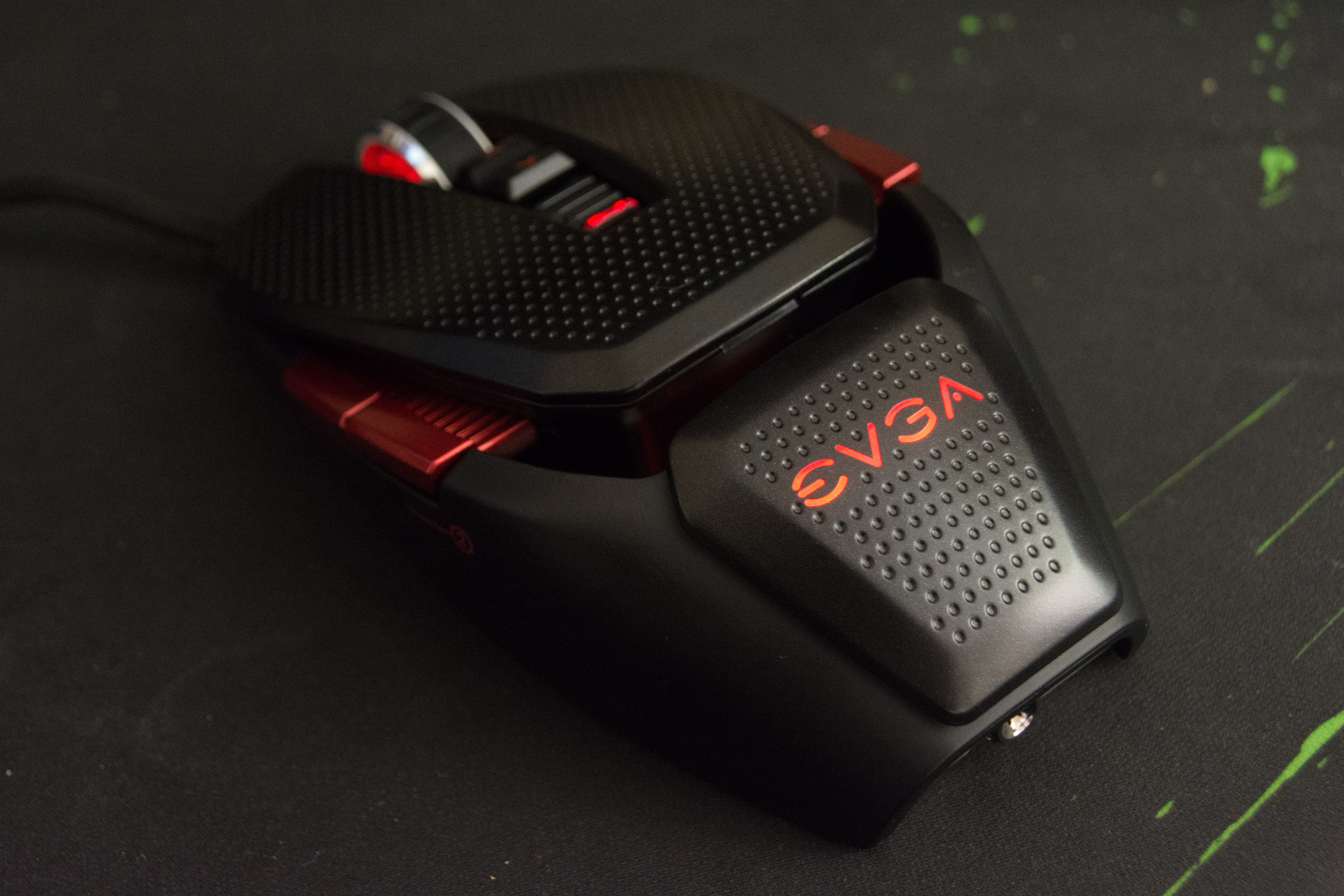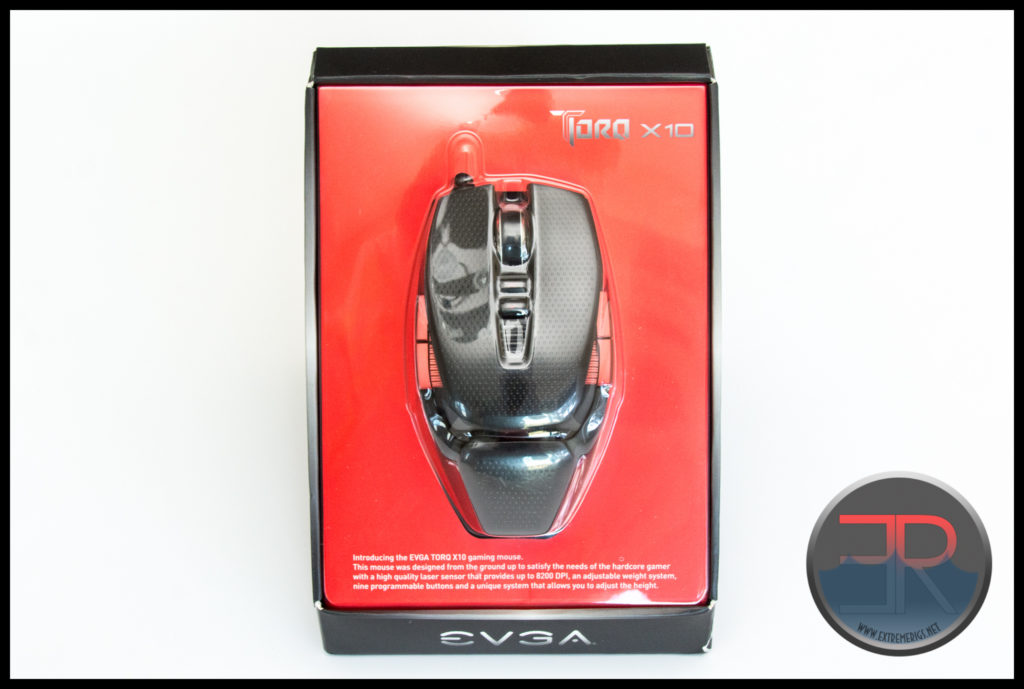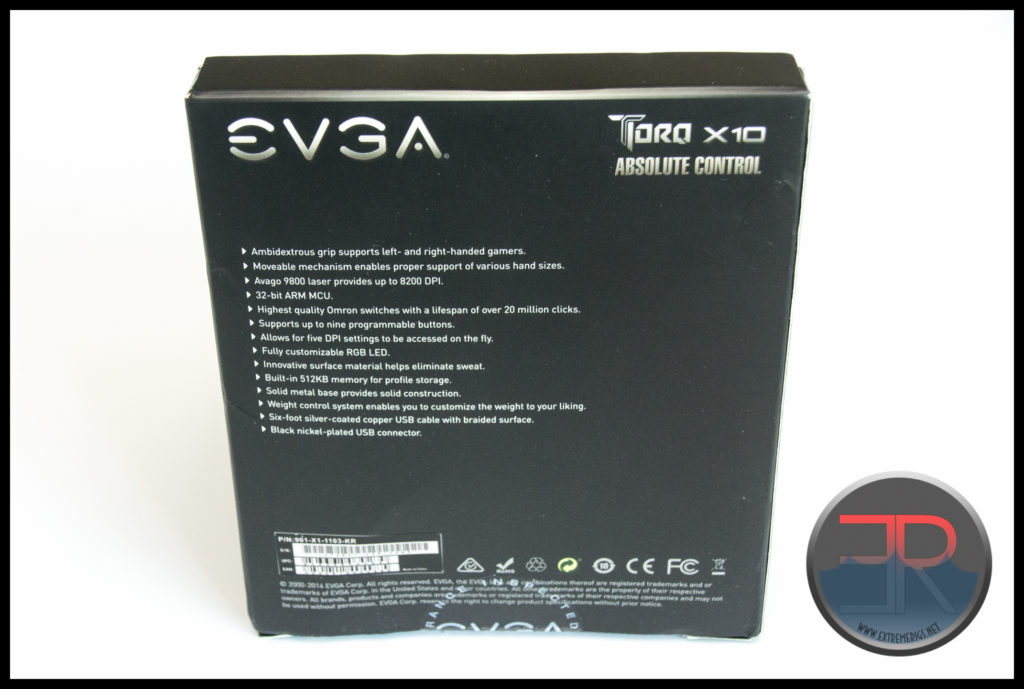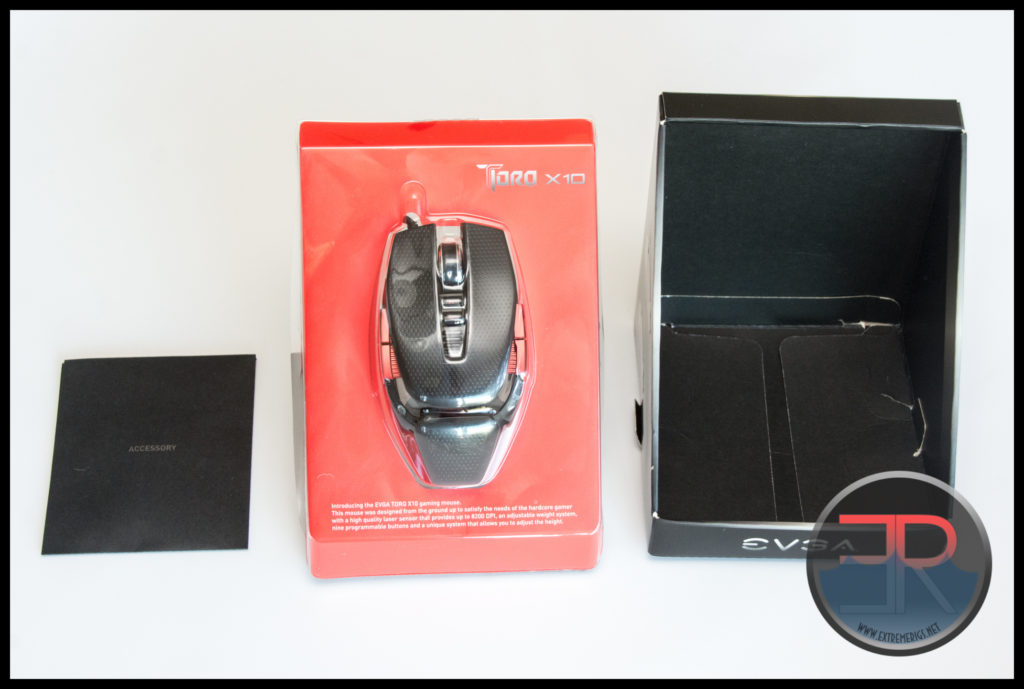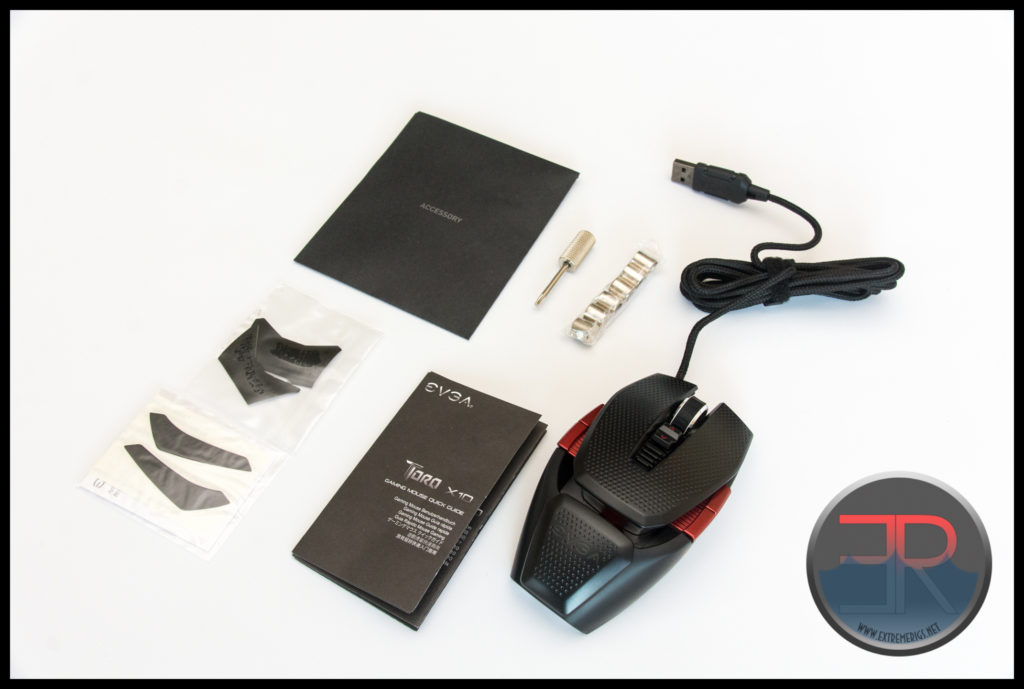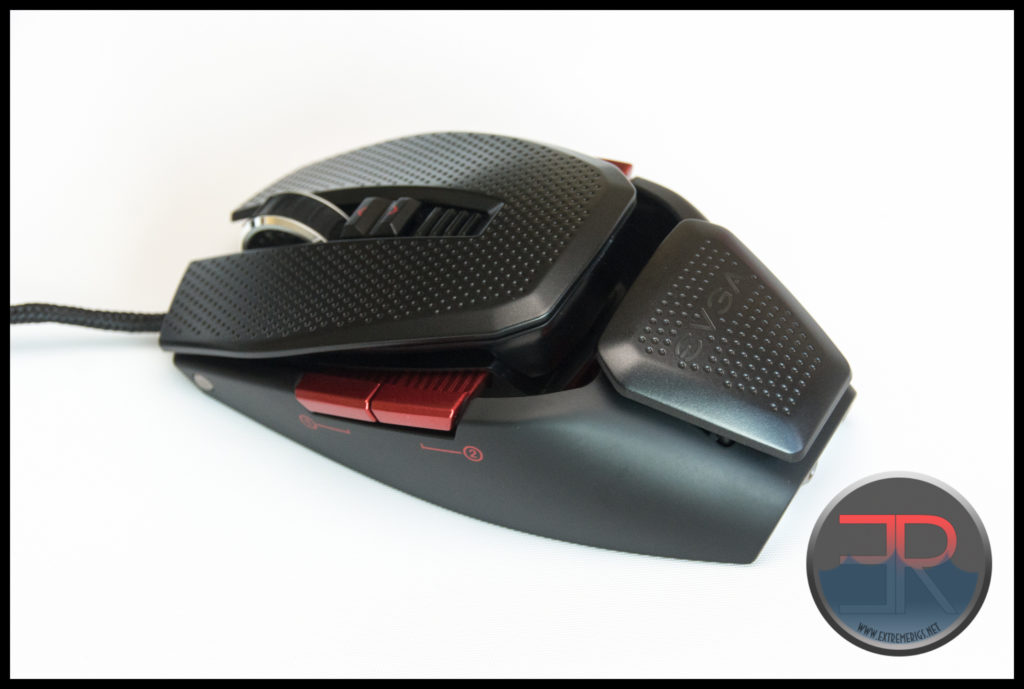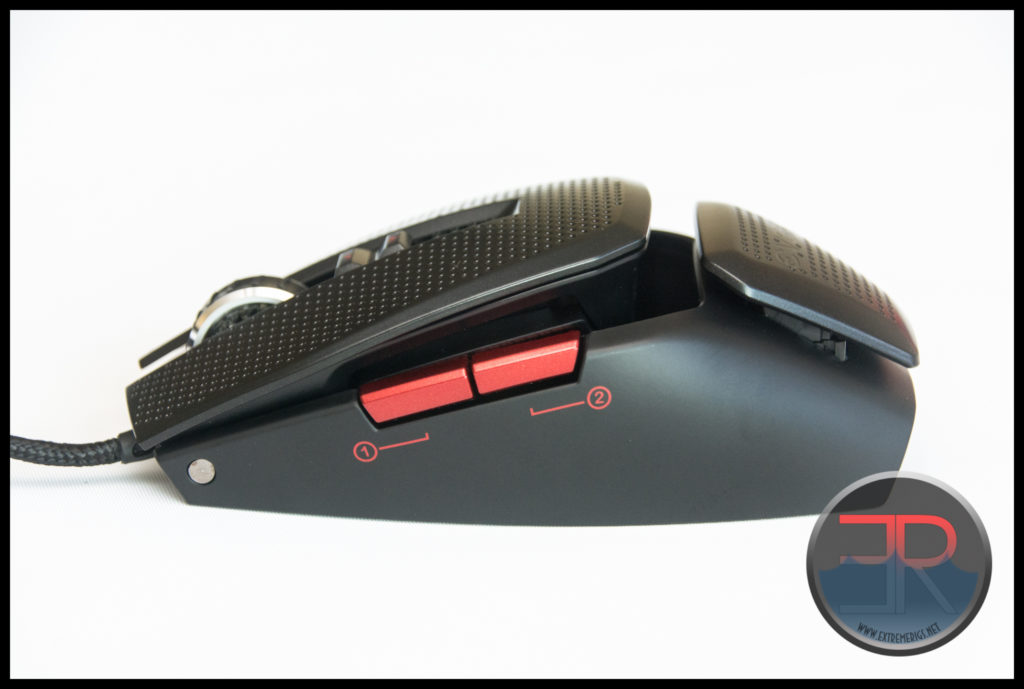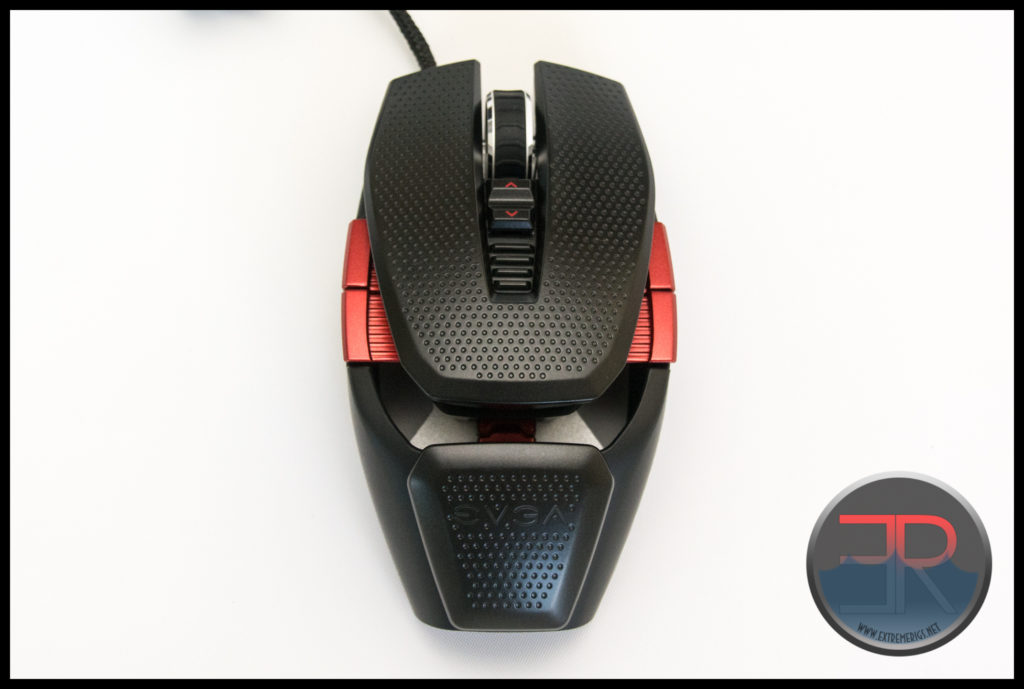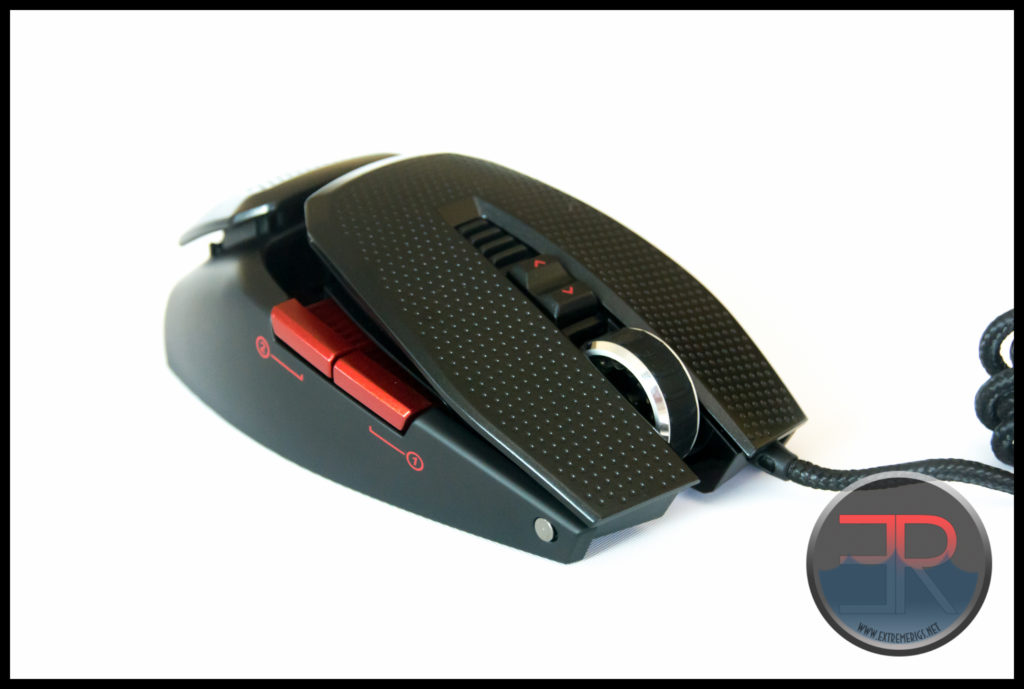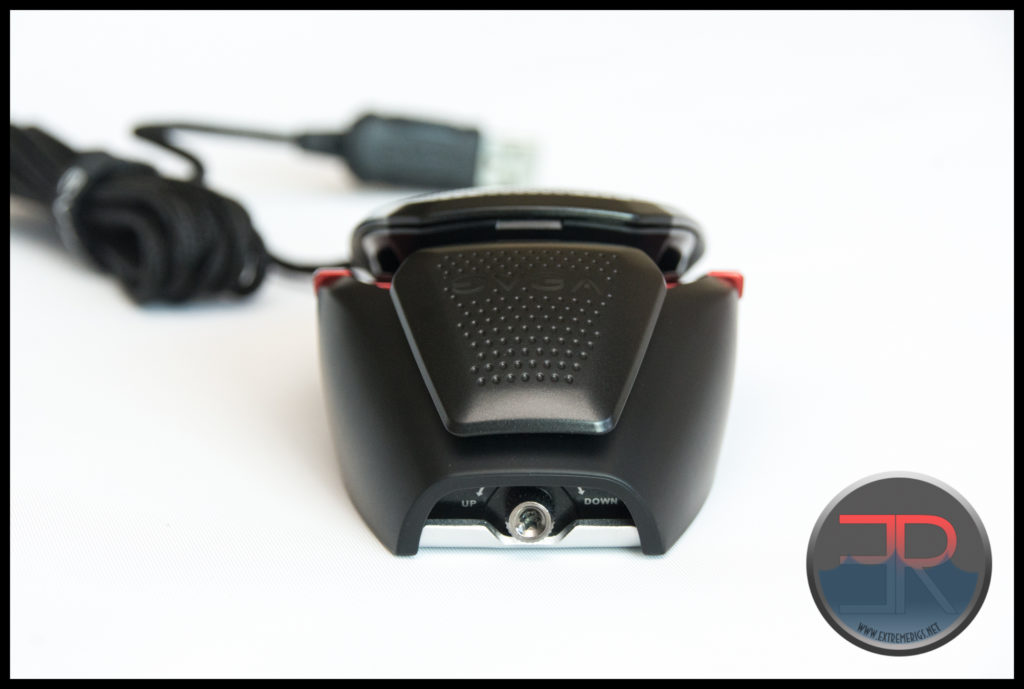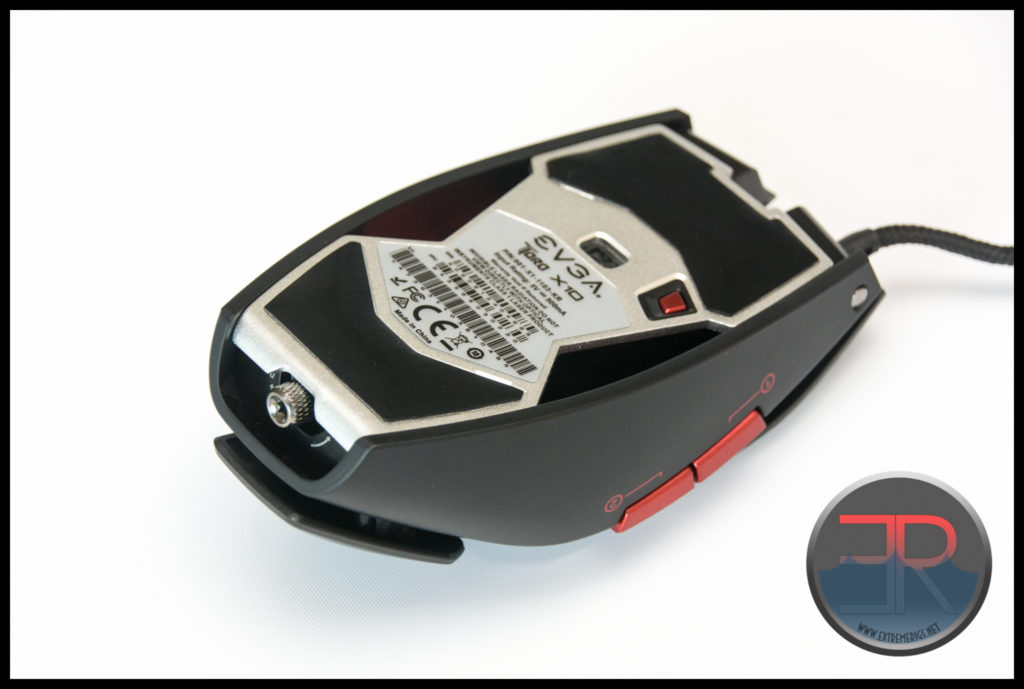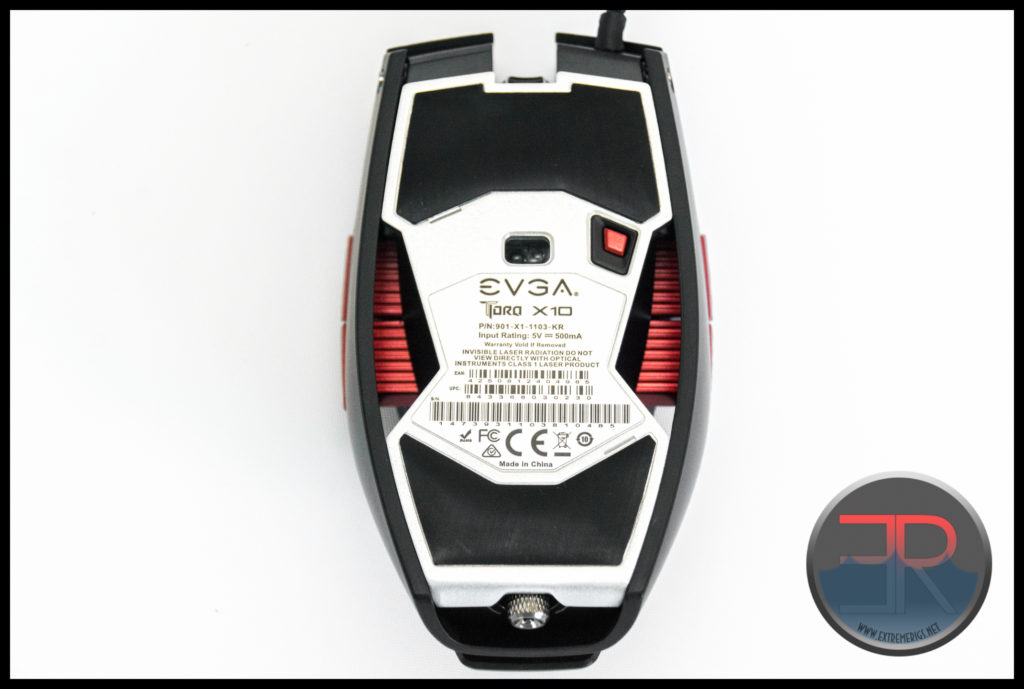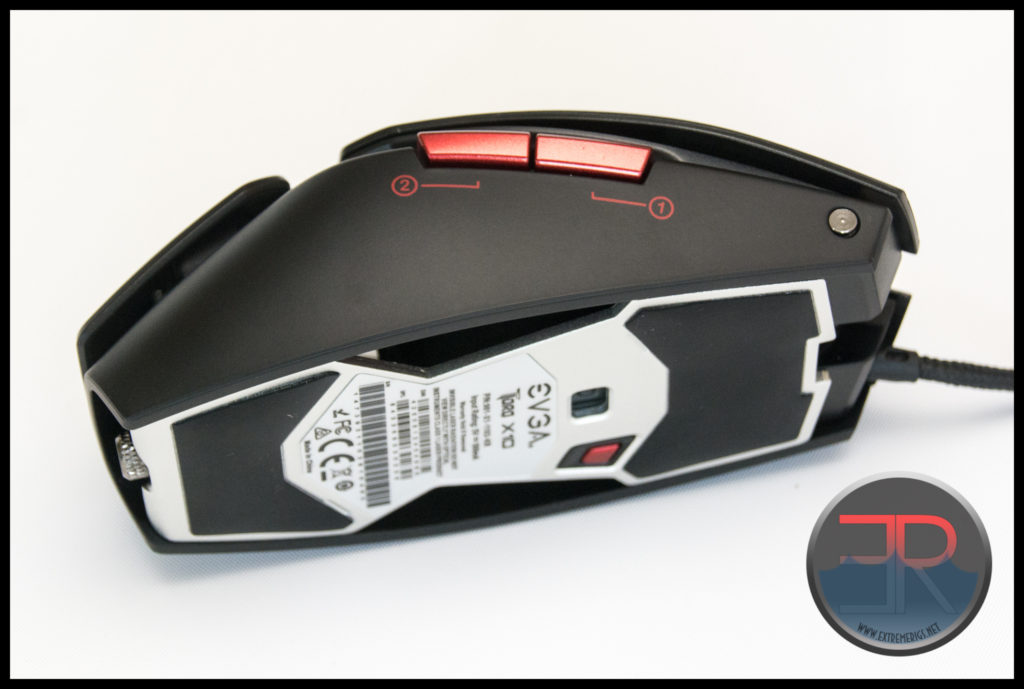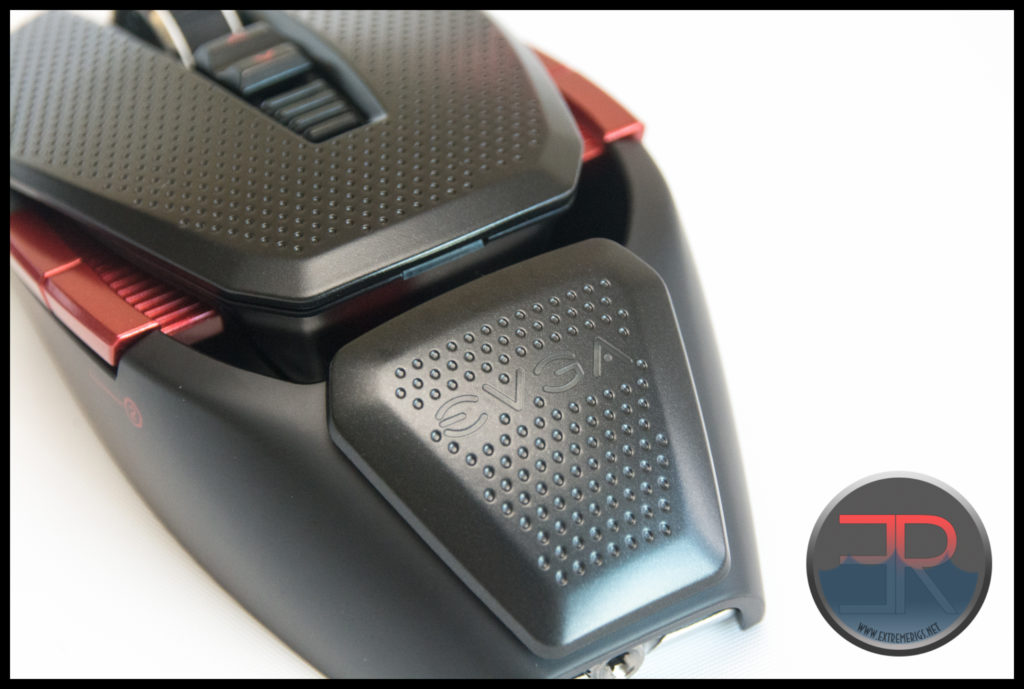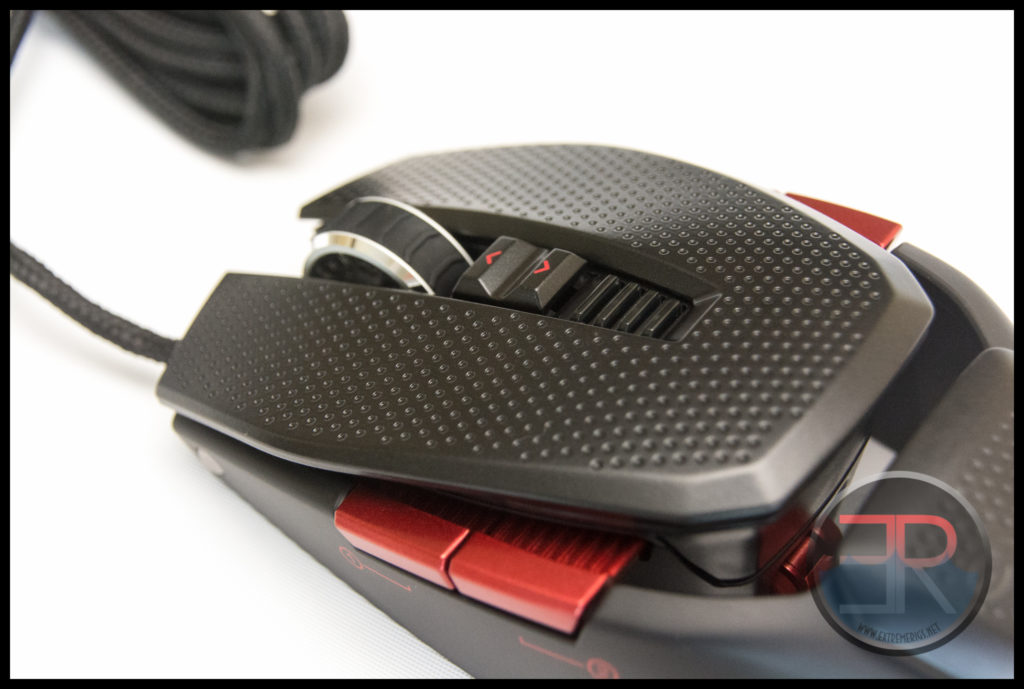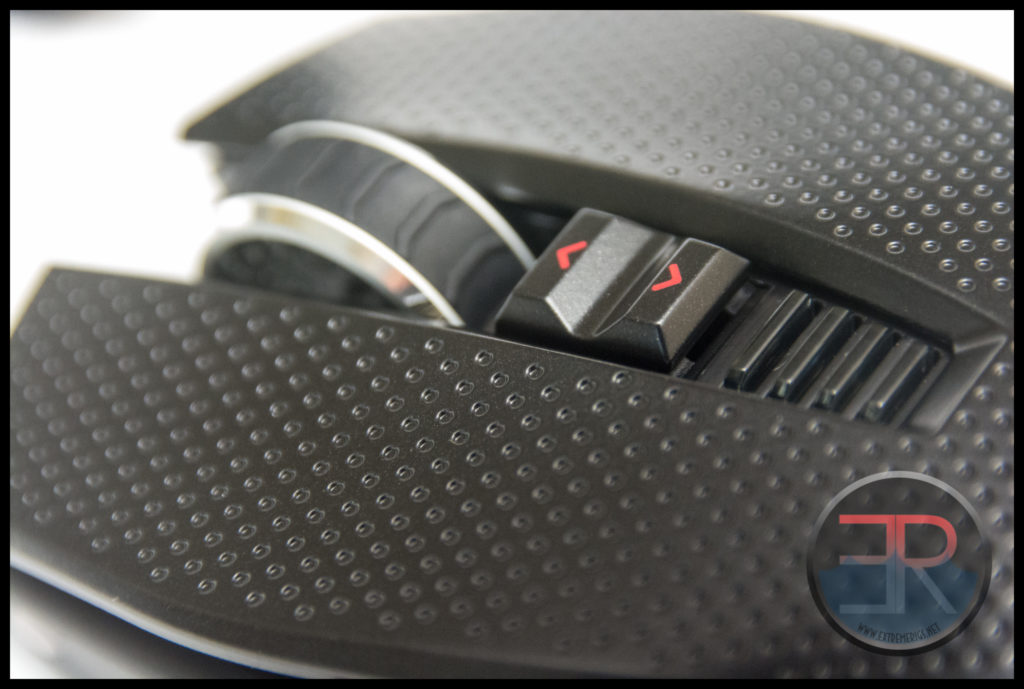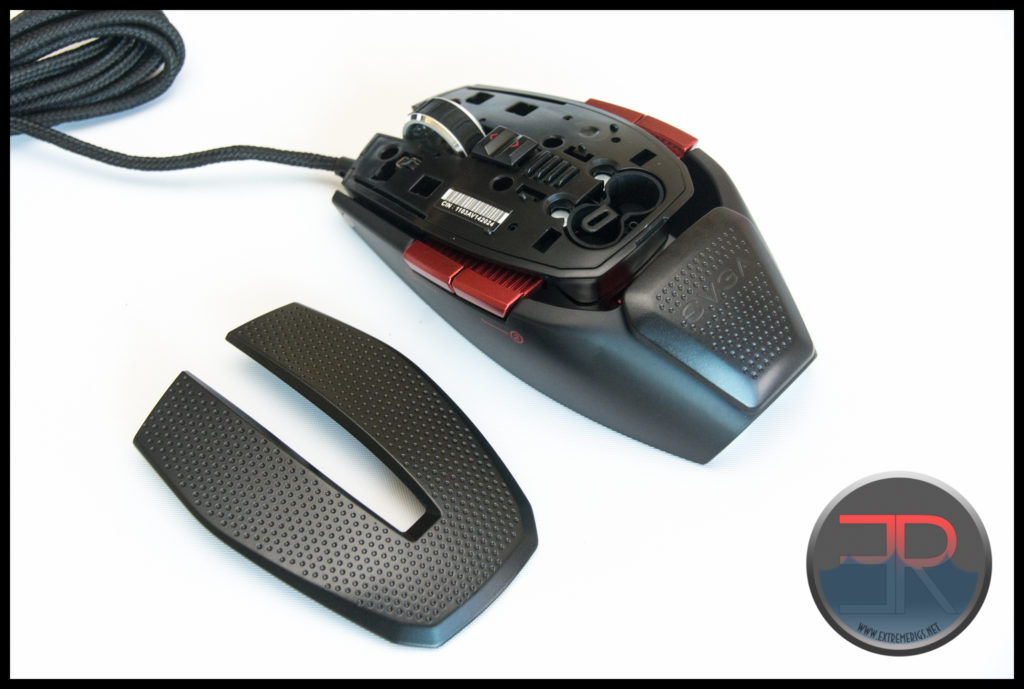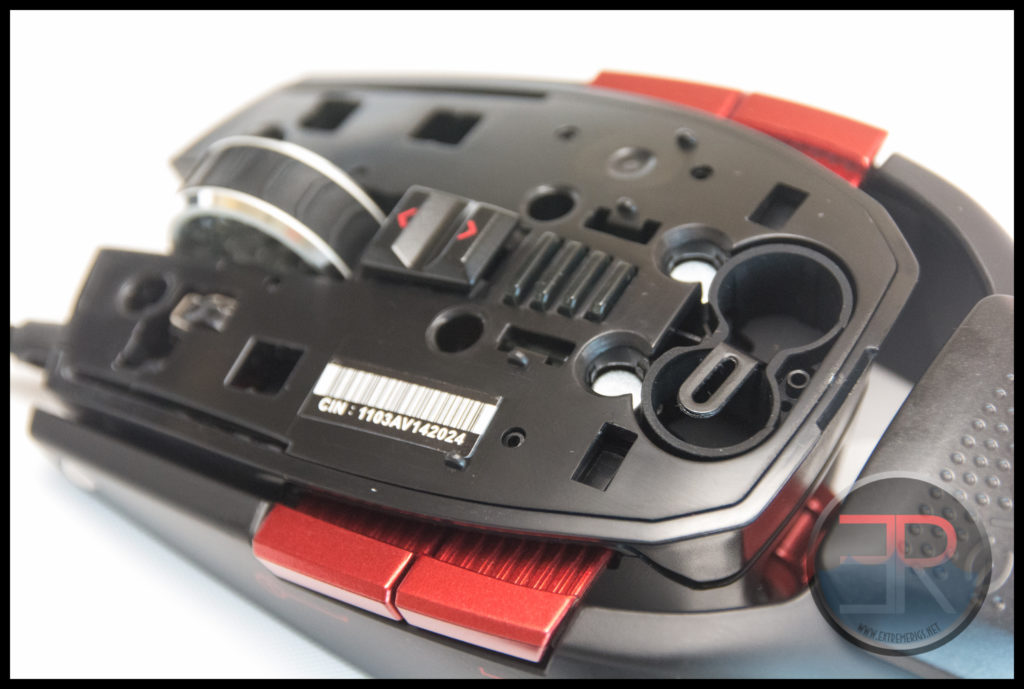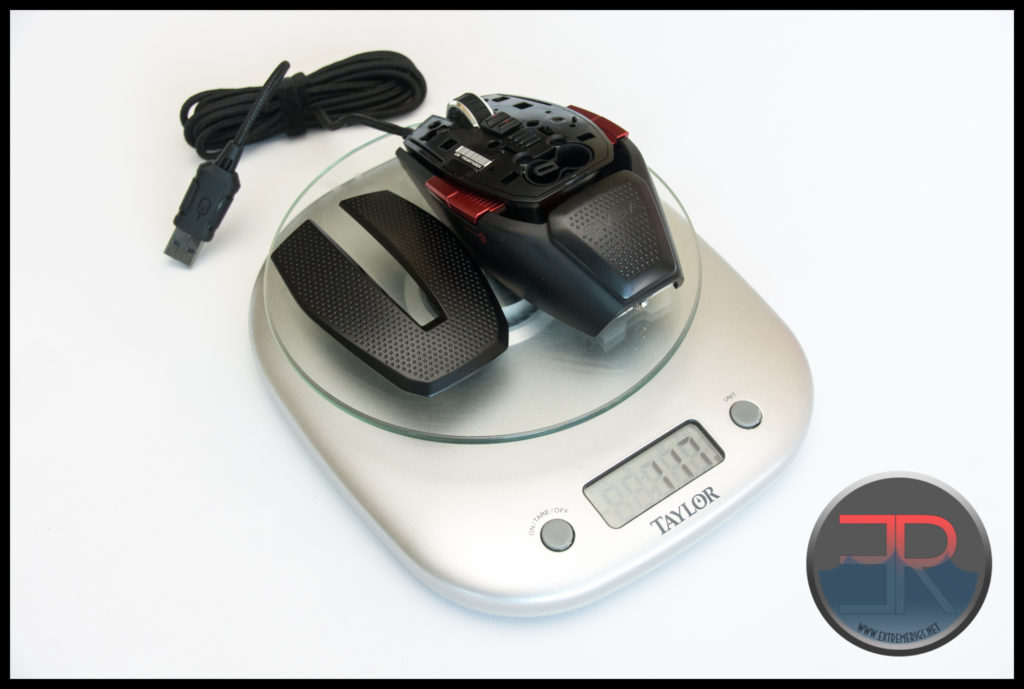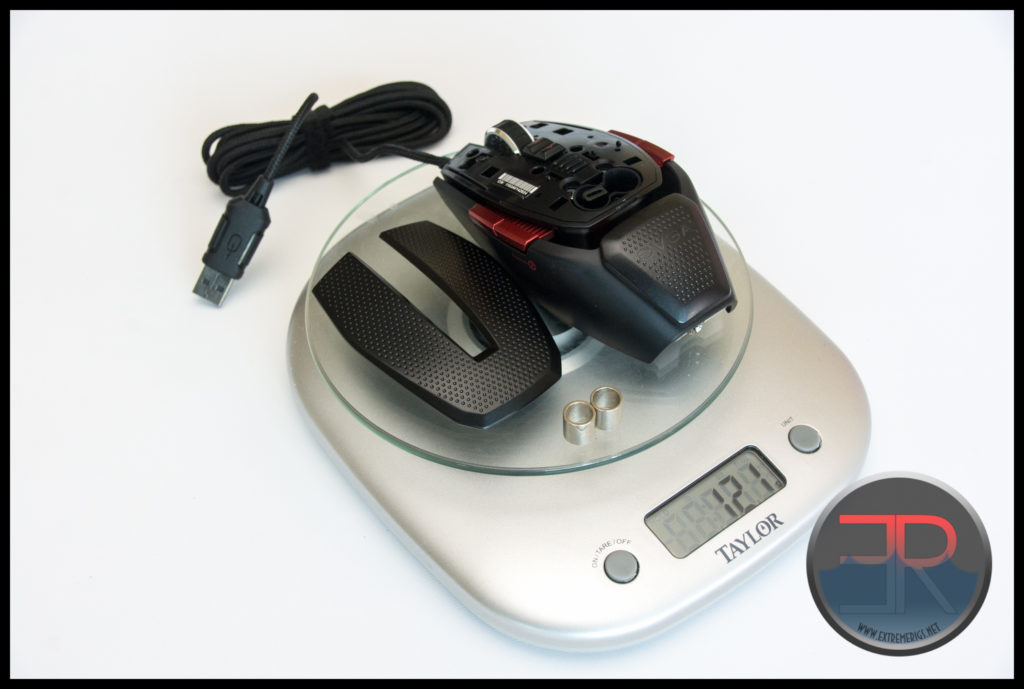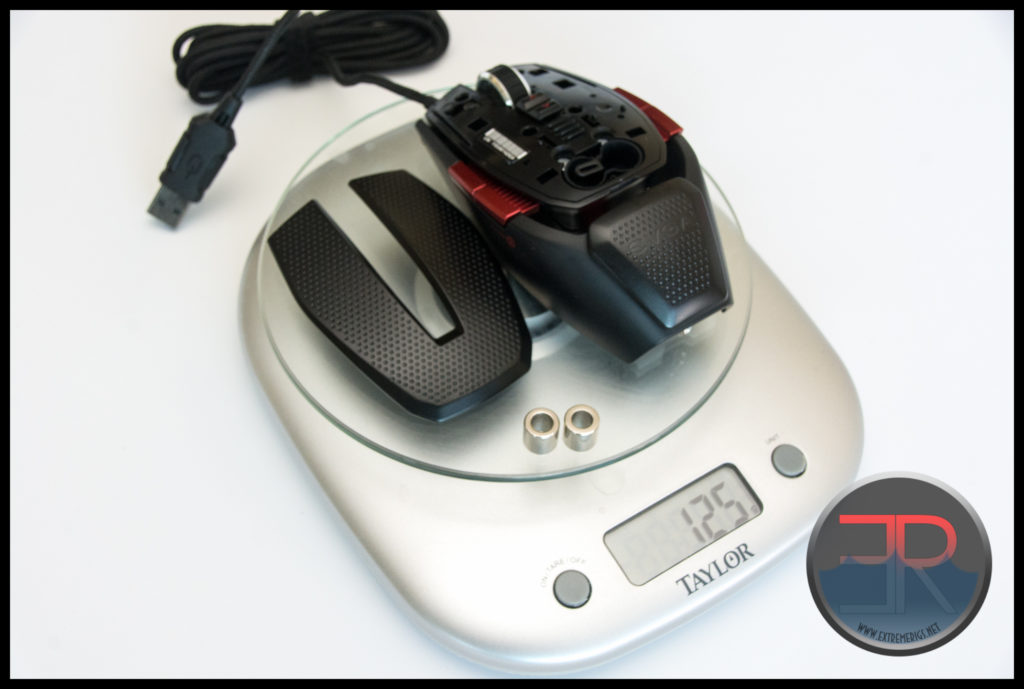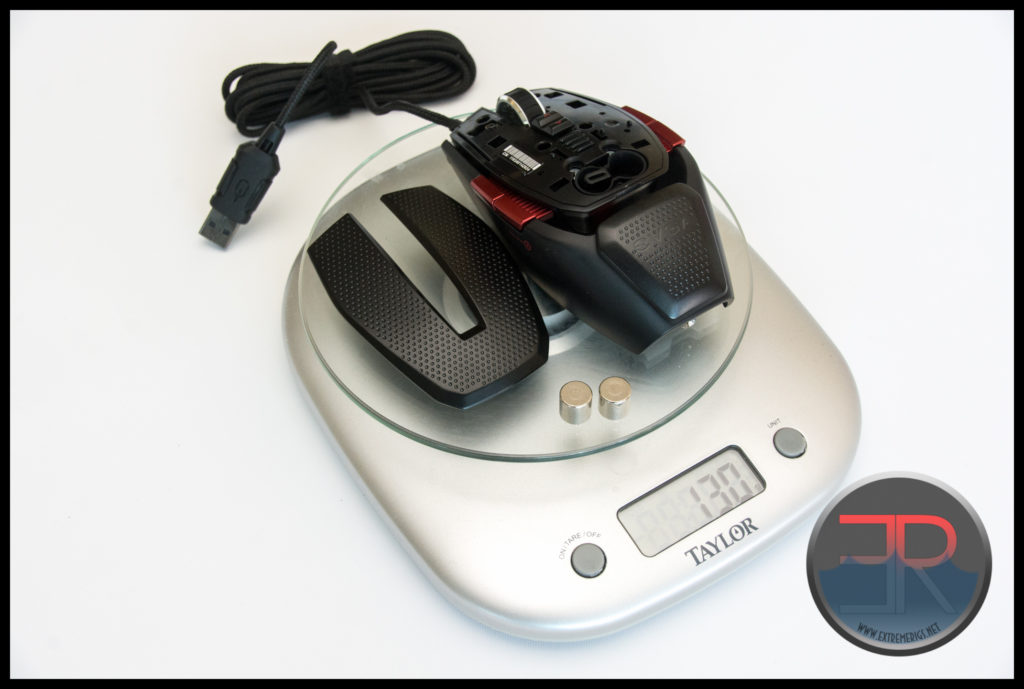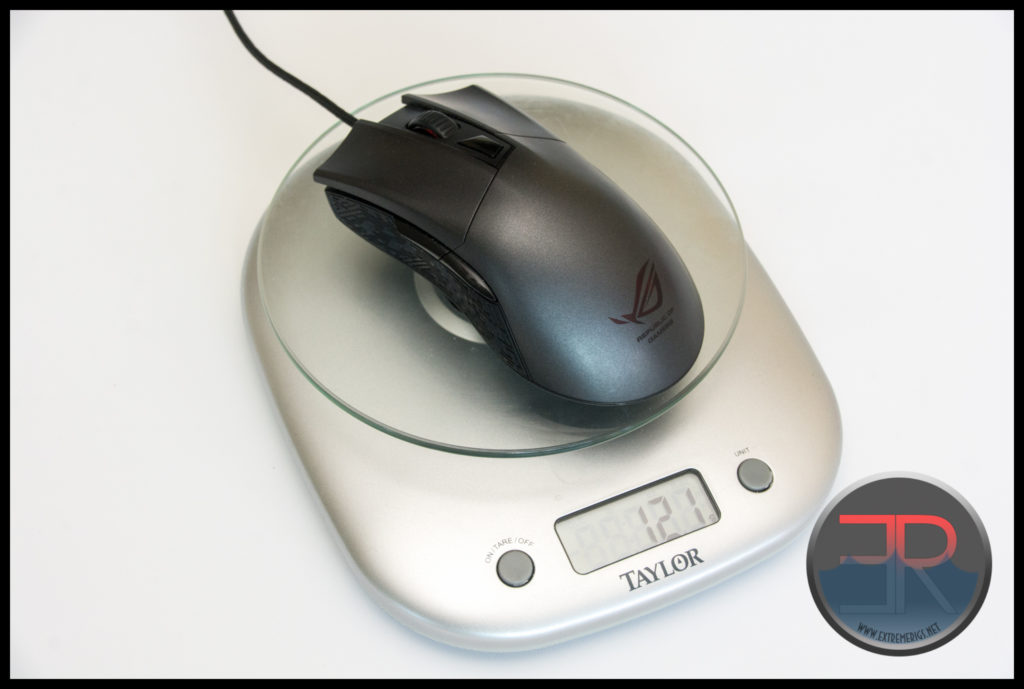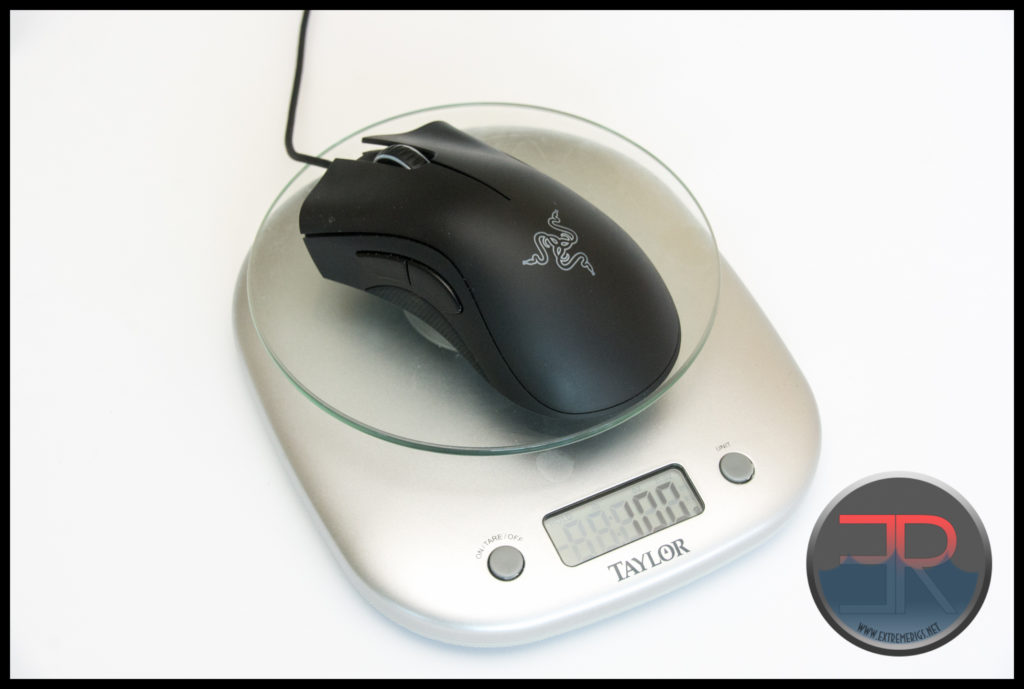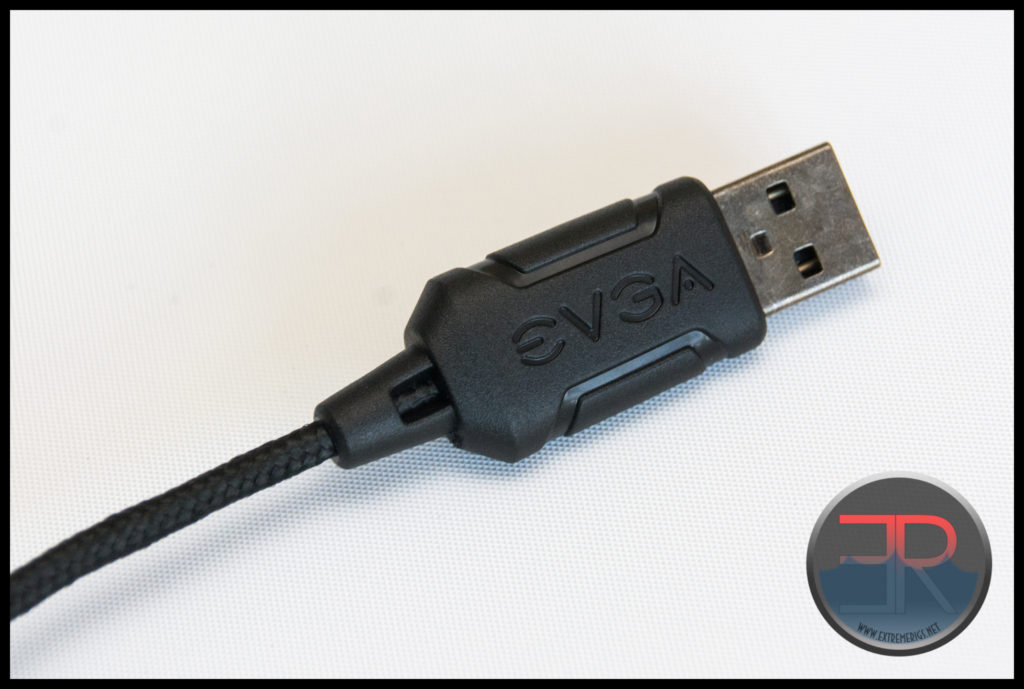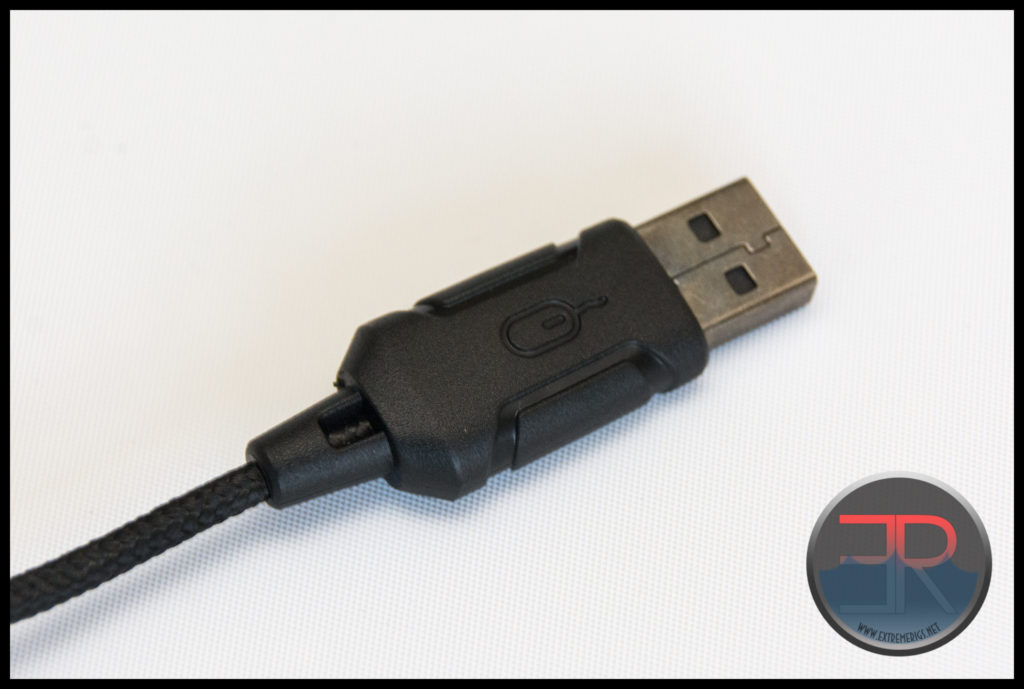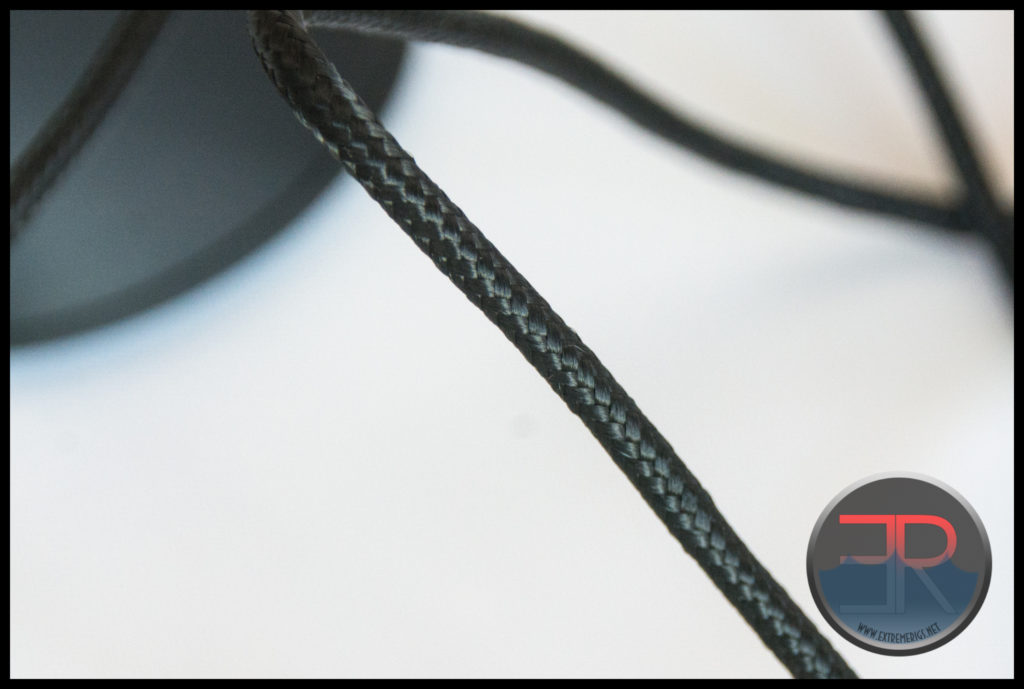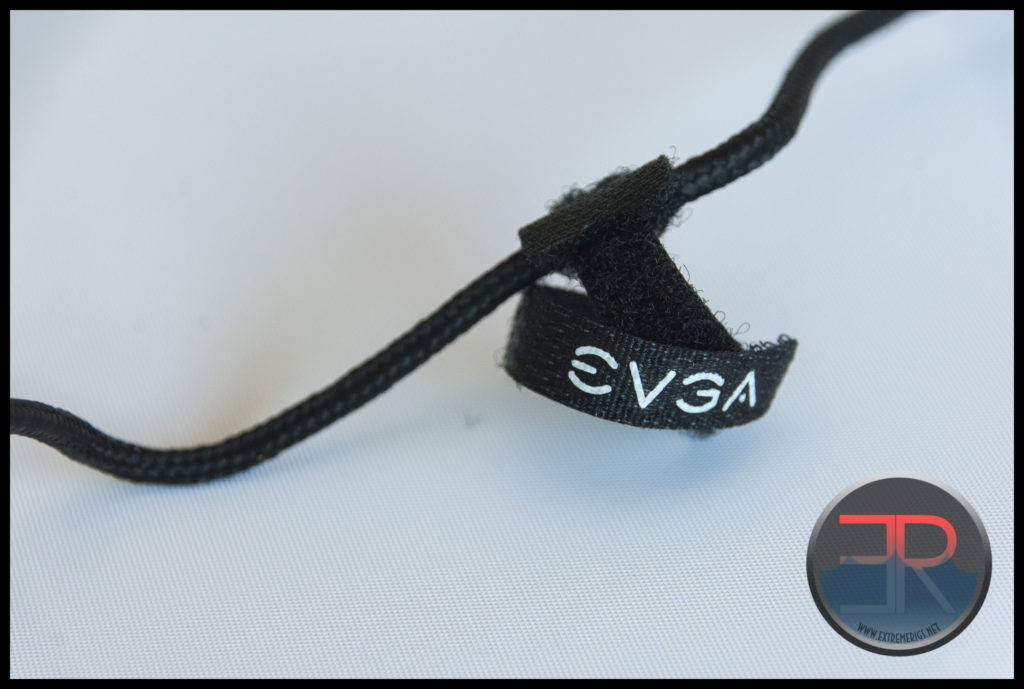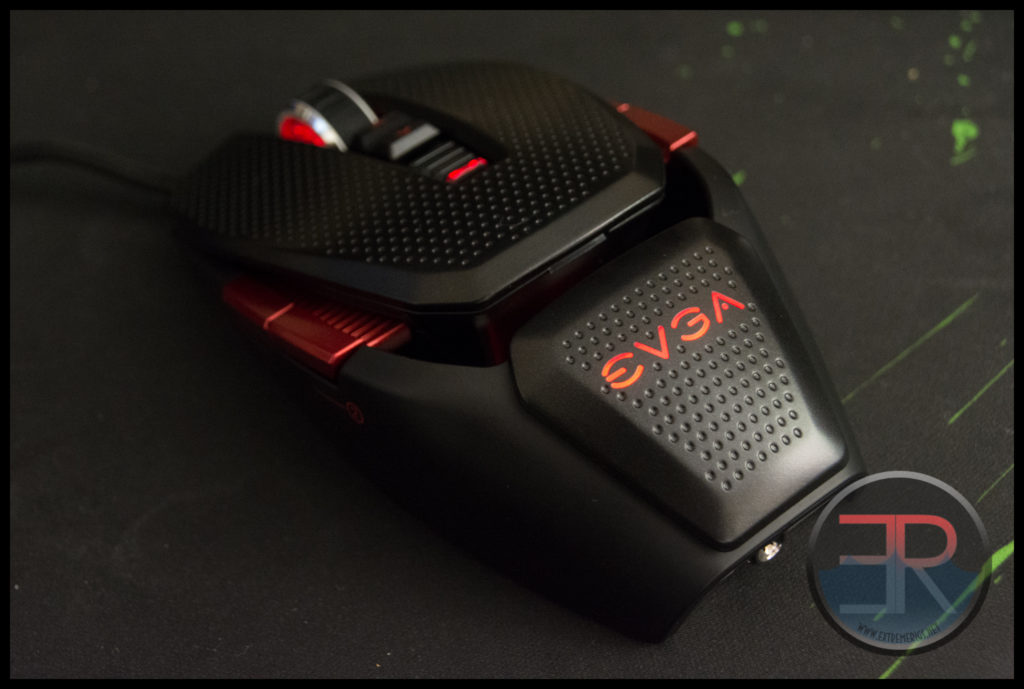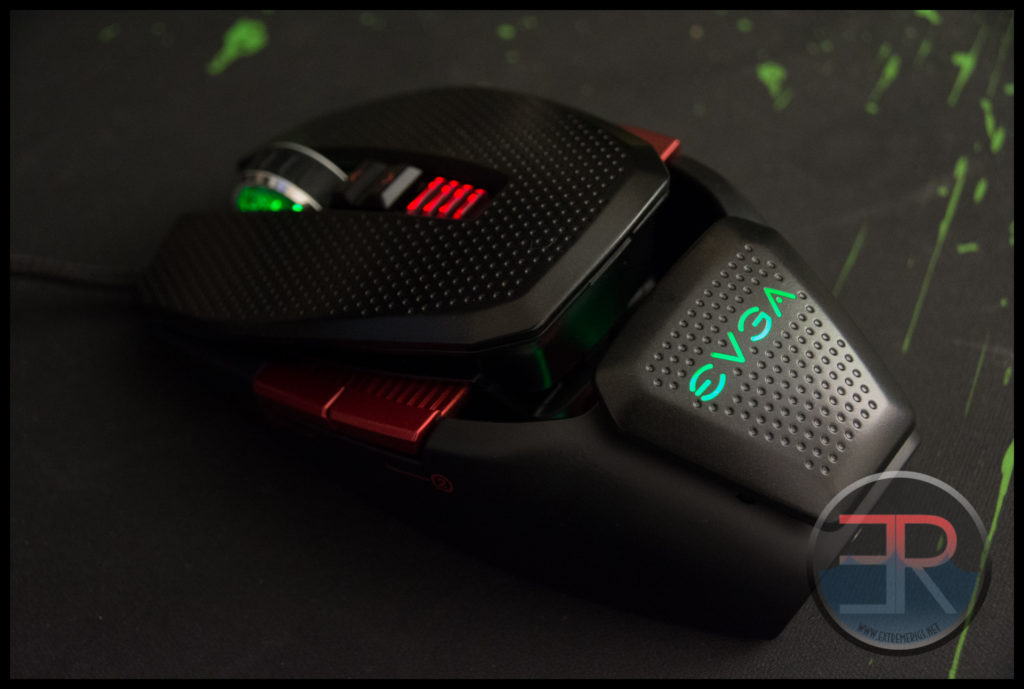EVGA Torq X10 Mouse Review
Welcome to the EVGA Torq X10 Mouse Review – another data driven review brought to you by the Extreme Rigs team. A big thanks to EVGA for their sponsorship – without which these reviews would not happen.
The Torq X10 is EVGA’s high end mouse offering. There are two versions of the X10 – a regular version and a carbon version featuring genuine carbon fiber construction.
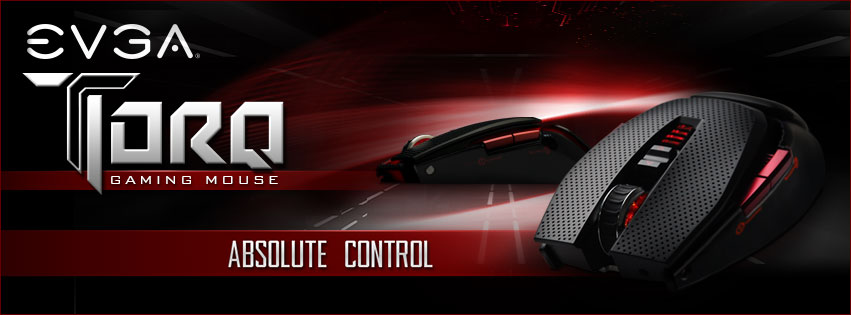 Today we will be taking a look at the regular (and cheaper) version of the X10:
Today we will be taking a look at the regular (and cheaper) version of the X10:
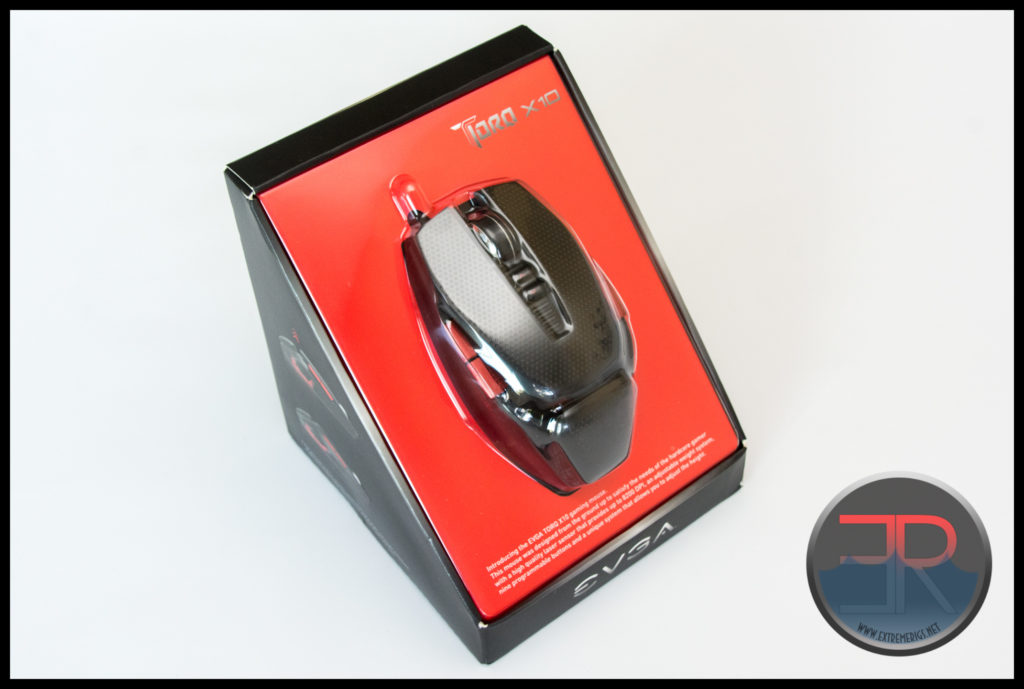
Let’s open up that unusual but usefully shaped box and see what we have.
The front of the box tells you surprisingly little information. In fact it almost looks like there’s a piece of the box missing. However the good news is that it is quite easy for someone in a brick and mortar store to try the shape of the mouse without buying it. This is good because for most people the shape and comfort factor in the hand is the number one reason they love or hate a mouse. Features are cool, but if it’s painful to use then it’s going in the trash pretty quickly.
The back of the box is where the marketing details are. Again nothing fancy on the packaging, just a bullet point list of features. Let’s go through these one by one:
- Ambidextrous grip supports left – and right-handed gamers
Yes this mouse is symmetrical – it also has two “thumb” buttons on both sides so it can be used by “lefties”. This is in contrast to most other high end mice that are designed only for “righties”
- Movable mechanism enables proper support of various hand sizes
The mechanism can adjust the amount of arch in the mouse’s “back”. It doesn’t adjust the position of any buttons or the x/y dimensions of the mouse.
- Avago 9800 laser provides up to 8200 DPI
The Torq X10 uses the Avago 9800 sensor which may be listed as 8200CPI – but is that really native to the sensor or is interpolated. Generally every mouse we’ve seen above 6400CPI seems to have some rumor about the higher CPI settings being interpolated in some form or another. Still if it’s “only” 6400CPI native, then that’s still good enough in our opinion, but it would be nice if companies were more clear about what the reality was.
Now while some users have found the sensor’s acceleration to be higher than normal and most importantly inconsistent – EVGA has confirmed on the forums that this version of the sensor has that problem fixed.
- 32-bit ARM MCU
EVGA are using a 32 bit ARM microcontroller in the Torq X10. Pretty thrilling info there.
- Highest quality Omron switches with a lifespan of over 20 million clicks
Omron and 20 million is pretty standard these days on a high end mouse. The real question – is whether every button is the same or whether some buttons have been cheaped out on. The other question is whether these switches are easily replaceable with a socket or not. The mouse’s warranty is voided if you open it, so I think it’s safe to say the switches are not socketed.
- Supports up to nine programmable buttons
While this is true (2 main buttons, 2 sets of 2 side buttons, up/down CPI buttons, mousewheel), the reality is that you’re likely to not be able to use all of those. If you keep the up/down buttons for CPI, and discount the “leftie” side buttons then you’re down to 5. The mousewheel button is at least easy to press and not overly stiff like some others.
- Allows for five DPI settings to be accessed on the fly
This is a good amount of variation. This gives plenty of options – and you don’t have to use all five – there is a choice to reduce the amount of settings. Someone who just wants a sniper setting for example might just want 2 settings only. It should be noted that you can also store multiple profiles with up to five on the mouse – so you can have up to 25 different CPI settings stored on the mouse at a time if you wanted.
- Fully customizable RGB LED
There are actually 2 LED’s which can be customized independently. There are 7 colors to choose from as well as a brightness control. To me this isn’t quite the fully customizable you might be used to. There are no 256 colors to choose from, nor are there any additional color cycling modes beyond “breathing”. It should be noted that there is a third LED used for the current CPI setting which is always red and can not be customized. More on that later.
- Innovative surface material helps eliminate sweat
There are dimples in the surface – I assume the slightly dimpling makes it easier to ventilate and for sweat to be desposited. I don’t suffer from extremely sweaty hands so I didn’t notice any benefit or problem.
- Built-in 512KB memory for profile storage
Built in memory is a good thing for those who often game on other’s systems. It also means a mouse can be setup on windows and used on other systems like linux.
- Solid metal base provides solid construction
The base is indeed a pretty solid piece of metal
- Weight control system enables you to customize the weight to your liking
Weights are provided – details of this later in the review
- Six-foot silver coated copper USB cable with braided surface
I’m not sure of the benefits of silver coating copper to be honest. While gold doesn’t oxidize both copper and silver do. It reminds me of the high end audio scene where people claim to hear the difference between very similar high end cables. If you think silver plating helps a short cable like this carrying a digital signal with a high signal to noise ratio, then well, I don’t know, be excited I guess? Personally I think it’s a wasted money.
- Black nickel-plated USB connector
It’s strange that EVGA gave us a silver coated wire, but then gave a nickel plated connector. I would have expected standard wire but a gold plated connector. Oh well.
So that’s it for the specs – no mention of macro support or 1000Hz polling either which are both included.
Now let’s get the box open:
The accessory envelope includes a “Quick Guide” and replacement mouse feet. Inside the main plastic package is a tool to adjust the mouse’s arch, and a pack of weights to adjust the weight.
The mouse has a black/red theme that is typical of almost every EVGA product. While we have no complaints about this it does make the inclusion of RGB lighting somewhat surprising.
The “thumb” buttons are labelled 1 & 2 – this seems unnecessary and makes the design less “clean”. It’s also bizarre because as we see later on – in the software they are labelled as 4/5 and 6/7 depending on the side of the mouse.
This side view also let’s us see the arch a little. The two plates on the top of the mouse which are separated can be pivoted to increase the arch. The pin for one of the pivot points can be seen on the base to the left side.
When fully arched the gap between the two dimpled “plates” grows and so more of the internals can be seen. It’s also clear that the thumb buttons that you touch are quite far from the switches. This photo also shows us just how symmetrical the mouse is.
The only way you can tell I haven’t simply mirrored this photo to show the other side is the positioning of the usb cable.
At the “heel” of the mouse you can see the screw that is used in combination with the provided tool to raise or lower the mouse’s arch.
It’s a standard torx wrench, so if you lose it, then it should be easy to find one at your local hardware store. Underneath we see the large and thick metal plate that partially covers the base.
Interestingly there are cutouts in the metal base. We’re not sure why, but it looks cool I guess.
Incidentally the unlabeled tiny red button is a switch to change profiles. Each profile can have different lighting, button assignments, macros and CPI settings. This is one reason why despite the black/red theme that RGB lighting is still useful as it gives you a quick glance to tell which profile you’re on.
One thing that’s also noticeable is just how large the mouse’s feet are. This is unusual. A larger foot means more surface area touching the mouse pad and hence more friction.
There are also no rubberized side grips on the mouse, which means sweaty fingers may slip on the surface. Only the top surface is dimpled for better grip/sweat resistance, but even that is far from grippy.
The CPI switches are in a “normal” position just below the mousewheel. For my large hands they are not the easiest to get to, but that at least means you won’t be hitting them accidentally.
For weight adjustment the entire of the forward top panel unclips:
Two cylindrical weights can be added here:
The weights provided came in three pairs of varying weights. Mixing and matching will provide intermediate steps beyond the ones shown. Let’s go ahead and measure the mouse with these pairs:
Firstly with no weights added the mouse weighs 117g
Adding the first pair adds 4g, presumably 2g each.
The next pair adds another 4g, presumably 4g each.
The next pair adds another 5g and are presumably 6.5g each. So we have the ability to vary the mouse weight from 117g to 130g in roughly 2g steps, i.e. roughly 10% adjustment. So there is definitely some customization of the weight, but surprisingly not as much range as I expected.
How does this weight compare to our other mice:
Despite the Torx’s beefy metal plate it is still lighter than ROG’s gladius which clocks in at 121g.
The Deathadder on the other hand clocks in at only 100g – not a surprise given it’s “only just strong enough construction”.
Personally I like a light mouse – the weight of a mouse equates to more force put on a wrist that in my case is borderline RSI anyway. The 117g is acceptable to me though.
Now let’s take a look at the cable:
While we can’t verify the “silverness” of the cable we can see that yes a black nickel finish has been used on the plug. I’ve never been a fan of black nickel. It’s not black enough to be sexy or shiny enough to look new.
Still I like that the plug is labelled with the brand, and even more that the other side is labelled with a mouse:
It may not sound like much but when you’ve hidden your cables away behind a desk or in a conduit it can be hard to know which black braided usb cable is which when it hits your rig.
The wire braid is tight and firm meaning it shouldn’t catch on any sharp corners:
We did not verify if it was dog chew proof however.
Also included is a velcro wire tire to help with your cable management. This is always appreciated.
Now let’s talk about the “RGB” LED Lighting – the default is red which matches the mouse’s theme:
The EVGA logo is lit by one LED, while the mouse scrollwheel is lit by another. Each of these can be set independently.
The current CPI setting however is always lit by a RED LED which is really disappointing as that should be able to be set to match the other colors.
Lastly now let’s take a look at the accompanying software before we get stuck into some testing.








